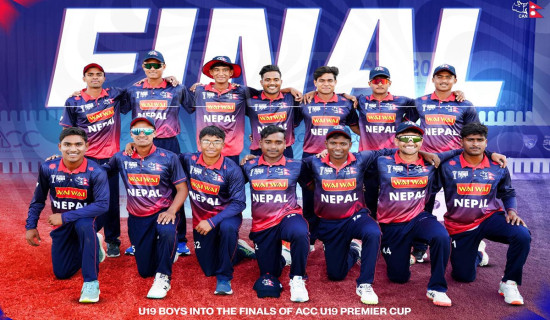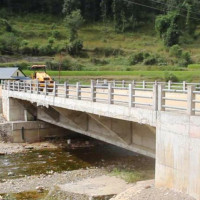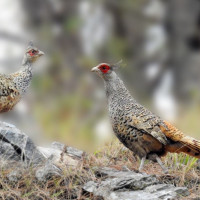- Saturday, 29 November 2025
Olanchungola Holds Untold Stories
Silent, timid, and aesthetic, Olanchungola is surviving, showcasing its picturesque village, nature, and culture on the eastern side of Nepal. This corner of Nepal, set on a narrow, flat land flanked by rocky hills, embraces the Tamor flowing in between. The short trip to Olanchungola was breathtaking and full of adventures, with its not-so-vehicle-friendly roads, rivers, and waterfalls. Yet, it was worthwhile for its peaceful and tranquil nature and culture.
The official and all pre-planned trips to Olanchungola required re-plans, as our schedule had to be adjusted as per the availability of vehicles in Taplejung since, in reality, very few residents dared to travel through the ups and downs to Olanchungola. So, we adapted, coordinated with local transportation, and pushed forward, determined to reach the people and places that awaited us. The trekking trail, which was recently upgraded for motors, looked like a walking track and was not for faint-hearted people.
We decided to conduct an official inspection of the age-old monastery of Olanchungola and soon return to the usual official work in Kathmandu. Our trip was planned with a personal vehicle reserved from Kathmandu and some warm clothes in our luggage. However, realising that even the local drivers were reluctant to reach the destination, we had to wait a day further in Taplejung for a specially redesigned vehicle with high road clearance. Only two drivers, among so many locals, muster the courage to journey to Olanchungola; however, they must only do so when enough passengers are available.
Upon travelling to Olanchungola, we realised why so few people decided to drive in such terrain. As we move along the beautiful Tamar River, everyone is mesmerised initially, with friendly passengers and courageous drivers. Nevertheless, as we gained altitude and again descended, our hearts stopped at some moments, and at a point, even the locals feared for their lives. Traversing the narrow trails and temporary pathways, our respect deepened for the strength and patience of its residents. There were some sharp turns where even the vehicle had to move in a backward direction as the pathway was not wide enough. Some moments were marked by complete silence, with only the exchange of glances among colleagues when our vehicle had to be a boat, literally crossing Tamor.
However, upon reaching Olanchungola after almost a day-long journey, we were greeted by the Buddhist flags waving in the cold breeze among the neatly constructed wooden houses. This often less-travelled community was bold and spellbinding, making us forget the emotional turmoil of the way and soon engulfed with tranquillity and peace. Silence as we walked along the stone-paved paths among chorten (stupa), mani walls, and prayer wheels brought in the true essence of the journey. Homestay, as developed by the community to welcome guests, was the only option for a stay. The community's hospitality made everyone feel like they had a home away from home, and the cosy, warm interior was all we required after day-long ups and downs.
Reaching Olanchungola and getting out of it both were dictated by weather and availability of transport, which is a stark cue of the ground reality of remote areas where infrastructure is not a mere convenience but a lifeline. So, even after finishing the work, we had to wait a day again to finally get back to Taplejung as an adjustment to the nature and availability. However, the locals were so friendly and understanding that a diver drove us to Taplejung in the evening after a day of waiting. It was a hard decision, as the journey was scary in broad daylight, and I had to travel in the dark.
To state it precisely, the trip is a souvenir of how life is full of unexpected twists and turns. Back in Kathmandu, many professionals were resorting to roads as a protest demanding their rights. However, this friendly community was surviving on scarce resources with insufficient sustainable production given such climatic and soil conditions, making it critical to external supplies at the Taplejung or China border. Yet, they had no issues meeting their needs with a few agricultural productions, animal rearing, and carpet weaving. When Kathmandu was burning with the scorching sun, Olanchungola was enduring metaphorically not only the harsh weather but also the weight of limited development. Many villages saw local road expansion initiatives and improving provincial coordination as hopeful signs. It was an eye-opener to how we should learn and improve independently rather than just complaining and blame-shifting.
With only a countable number of residents, many houses were locked as people looked for better education and lifestyles in the urban areas of Taplejung or Kathmandu. This has been the fate of many remote-area dwellers. Therefore, Olanchungola is not the forgotten corner but the frontier of possibility, resilience, and identity. It waits to be recognised as a not-to-be-forgotten destination in the Kanchenjunga Conservation Area. Its resilience is symbolic of continuing the culture of weaving traditional carpets. Their resilience is not born of resignation but deep-rooted pride and belonging, which any development plan must honour.
The majestic Deki Chholing Gompa, looking after the entire village from its height for more than 450 years, waits for government presence to conserve and preserve the religion it has been following during these hundreds of years. The Tamor River is gradually expanding towards the village and looking for timely intervention before submerging the entire region. Though government signboards, school buildings, border offices, and local administrative structures serve as beacons of national inclusion, the process has to be accelerated to ensure these offices function consistently and are adequately resourced.
It is a beautiful and bold village in its endurance, quietly shouldering the burdens of unforgiving geography, extreme climate, and limited accessibility. However, this settlement has enormous potential to be developed as a vibrant community with a strategic cultural and trade gateway that plays a strategic role in the inclusive development envisioned under federal Nepal. Olanchungola is an unambiguous reminder of how development is not a one-size-fits-all – and so, if given due attention to its unique geographies and communities, it will amplify its importance in the story of Nepal's inclusive growth. Designing climate-resilient infrastructure, cross-border trade facilitation, customised education systems, and youth retention strategies can make Olanchungola a frontier of possibility, resilience, and identity.
(The author is a technical officer at the National Archives of Nepal.)





-square-thumb.jpg)










